
A deer or true deer is a hoofed ruminant ungulate of the family Cervidae. It is divided into subfamilies Cervinae and Capreolinae. Male deer of almost all species, as well as female reindeer, grow and shed new antlers each year. These antlers are bony extensions of the skull and are often used for combat between males.

The Irish elk, also called the giant deer or Irish deer, is an extinct species of deer in the genus Megaloceros and is one of the largest deer that ever lived. Its range extended across Eurasia during the Pleistocene, from Ireland to Lake Baikal in Siberia. The most recent remains of the species have been radiocarbon dated to about 7,700 years ago in western Russia. Its antlers, which can span 3.5 metres (11 ft) across are the largest known of any deer. It is not closely related to either living species called the elk, with it being widely agreed that its closest living relatives are fallow deer (Dama).
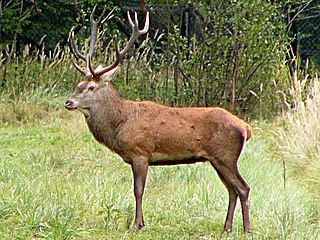
Cervus is a genus of deer that primarily are native to Eurasia, although one species occurs in northern Africa and another in North America. In addition to the species presently placed in this genus, it has included a whole range of other species now commonly placed in other genera. Additionally, the species-level taxonomy is in a state of flux.
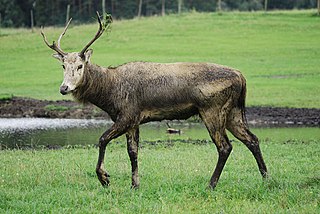
The Cervinae or the Old World deer, are a subfamily of deer. Alternatively, they are known as the plesiometacarpal deer, due to having lost the parts of the second and fifth metacarpal bones closest to the foot, distinct from the telemetacarpal deer of the Capreolinae.

Libralces was a genus of Eurasian deer that lived during the Pliocene epoch. Its main claim to fame is its 2+ meter wide antlers, comparable in size to those of Megaloceros.

Xenocyon is an extinct group of canids, either considered a distinct genus or a subgenus of Canis. The group includes Canis (Xenocyon) africanus, Canis (Xenocyon) antonii and Canis (Xenocyon) falconeri that gave rise to Canis (Xenocyon) lycanoides. The hypercarnivorous Xenocyon is thought to be closely related and possibly ancestral to modern dhole and the African wild dog, as well as the insular Sardinian dhole.

Odocoileus lucasi, known commonly as the American mountain deer, is an extinct species of North American deer.
The European Land Mammal Mega Zones are zones in rock layers that have a specific assemblage of fossils (biozones) based on occurrences of fossil assemblages of European land mammals. These biozones cover most of the Cenozoic, with particular focus having been paid to the Neogene and Paleogene systems, the Quaternary has several competing systems. In cases when fossils of mammals are abundant, stratigraphers and paleontologists can use these biozones as a more practical regional alternative to the stages of the official ICS geologic timescale. European Land Mammal Mega Zones are often also confusingly referred to as ages, stages, or intervals.

The Finnish forest reindeer(Rangifer fennicus fennicus, also known as Eurasian or European forest reindeer is a rare subspecies of the reindeer native to Finland and northwestern Russia. They are found primarily in Russian Karelia and the provinces of North Karelia, Savonia and Kainuu in Finland, though some range into central south Finland. They are distinct from the semi-domesticated mountain reindeer in their larger size, longer legs and preference for dense boreal forest habitat, where they are rarely seen by humans, over the open tundra. The Finnish herd migrates seasonally back and forth across the long Russo-Finnish border.
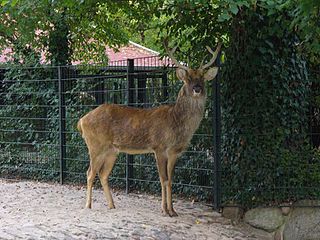
Rucervus is a genus of deer from India, Nepal, Indochina, and the Chinese island of Hainan. The only extant representatives, the barasingha or swamp deer and Eld's deer, are threatened by habitat loss and hunting; another species, Schomburgk’s deer, went extinct in 1938. Deer species found within the genus Rucervus are characterized by a specific antler structure, where the basal ramification is often supplemented with an additional small prong, and the middle tine is never present. The crown tines are inserted on the posterior side of the beam and may be bifurcated or fused into a small palmation.

Cervus elaphus acoronatus is an extinct subspecies of the red deer belonging to the family Cervidae. Some authors consider it a distinct species, Cervus acoronatus.

Cervavitus is a genus of prehistoric deer that lived from the late Miocene to the Early Pleistocene in parts of Western and Eastern Europe, Central Asia and China.

Praemegaceros is an extinct genus of deer, known from the Pleistocene and Holocene of Western Eurasia. Praemegaceros is often considered to be a genus of "giant deer" closely related to Megaloceros and Sinomegaceros, with many species having an estimated body mass of around 400 kilograms (880 lb), considerably larger than most living deer.
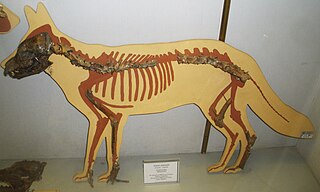
Canis arnensis, the Arno River dog, is an extinct species of canine that was endemic to Mediterranean Europe during the Early Pleistocene. The Arno River dog has been described as a small jackal-like dog. Its anatomy and morphology relate it more to the modern golden jackal than to the larger Etruscan wolf of that time. It is probably the ancestor of modern jackals.

Canis etruscus, the Etruscan wolf, is an extinct species of canine that was endemic to Mediterranean Europe during the Early Pleistocene. The Etruscan wolf is described as a small wolf-like dog.

Megaceroides algericus is an extinct species of deer known from the Late Pleistocene to the Holocene of North Africa. It is one of only two species of deer known to have been native to the African continent, alongside the Barbary stag, a subspecies of red deer. It is considered to be closely related to the giant deer species of Eurasia.

Sinomegaceros is an extinct genus of deer known from the Late Pliocene/Early Pleistocene to Late Pleistocene of Central and East Asia. It is considered to be part of the group of "giant deer", with a close relationship to Megaloceros. Many members of the genus are noted for their distinctive palmate antler brow tines.

Bretzia pseudalces, is a species of deer from the extinct genus Bretzia It is endemic to North America, with fossils found in the Ringold Formation in Washington.
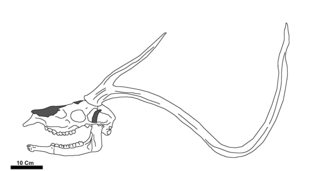
Haploidoceros is an extinct genus of deer that lived in Europe during the Pleistocene. It contains a single species, Haploidoceros mediterraneus. It had a distribution limited to southern France and the Iberian peninsula.

Euprox is an extinct genus of deer that lived in Eurasia during the Miocene.





















